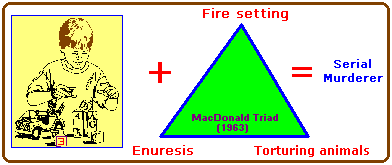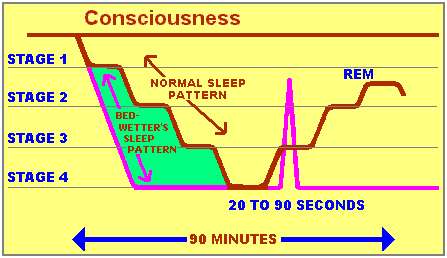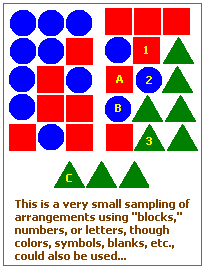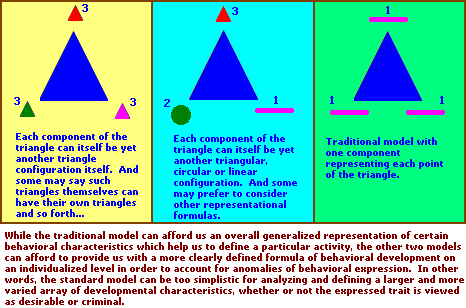page 1
(The Study of Threes)
http://threesology.org
3-part "MacDonald Triad" describing the development of Serial Murderers:

The Macdonald triad is a set of three behavioral characteristics which are associated with sociopathic behavior. These behavioral characteristics are found in the childhood histories of individuals with sociopathic behavior. It is also known as the triad of sociopathy. It was first identified by a forensic psychiatrist, John Marshall Macdonald (November 7, 1920 - December 16, 2007), in a 1963 paper in the American Journal of Psychiatry titled "The Threat to Kill". The Macdonald triad is considered predictive of future criminal behavior.
Information on the MacDonald Triad:
http://www.crimelibrary.com/serials/what/whatevents.htm
--- Classic Triads ...the beautiful threesomes of medicine ---
Triad means a three-way commitment among the chiefs of police in a county, the sheriff and older or retired leaders. They agree to work together to reduce the criminal victimization of the elderly and enhance the delivery of law enforcement services to older persons.
http://www.nationaltriad.org/background.html

The bedwetter goes very quickly into a very deep stage 4 sleep and stays there. After a while, (We do not know when exactly, it can be 30 minutes or hours) their bladder sends a signal to the brain that they have to go to the bathroom. Then they have a "Rapid R.E.M." rise in their sleep, (Please notice that it only lasts from 20-90 seconds...like the lengths of commercials) however they are in such a deep sleep that they are unable to respond (or wake up) and simply lose control in their sleep.
http://www.nightdry.com/
Is criminal behavior an expression of a particular stage of sleep-walking in which the individual "loses control" of a functioning consciousness similar to the lack of consciousness seen in the behavior of reptiles (or bicameral-minded people)? Recall that some criminals after having committed a crime, speak of a dream-like, surreal-type of mental state, as if they were watching themselves in a movie.
The following link may be of some interest:
http://www.threesology.org/criminal-2s1.php
Compare the above MacDonald triangle with the triangle used by fire fighters in describing the 3 components producing a fire:

--- Fire Safety Main Index Page ---
http://www.angliacampus.com/education/fire/index2.htm
The above three components making up a fire triangle can be seen as but a 3-part component of the single fire element in the MacDonald Triangle. It must thus be considered that the other two elements of the MacDonald Triangle may also be analyzed as triangular configurations, or on another level, representations of dual and single formulas that in total, illustrate a single - dual - triple formula... A formula which has correlations in other areas such as the triad of the biosphere:
- RNA is predominantly single stranded.
- DNA is predominantly double stranded.
- Proteins can have a primary - secondary - tertiary conformation, with a combination referred to as a quaternary structure. (The "Quaternary" in proteins would thus make the trio into a 3 to 1 ratio, like the "Zeroth law" in Thermodynamics.)
A more everyday example of three to one ratio might be cited as:
Unicycle - Bicycle - Tricycle.
While some readers may view the correlation as a great leap of imagination with respect to similarity of design, function, or application, this basic pattern seen in primary biology need not be limited to this domain, and in fact may suggest a pattern of cognitive usage. However, if we replace the numerical designations of single - dual - triple with linear - circular - triangular, or a square - circle - triangle, respectively, individualized considerations of the three individual components of the above triangles, approach the status of a quasi-like math formula that can be better grasped by those who are particularly visual in a non-mathematical sense.
 I don't want to go into an extended
analysis of the metaphorical similarities between these the MacDonald and Fire
triangles, since other triangle examples could also be incorporated on varying
levels, except to further point out the recurring usage of a 3-part triangular
configuration of inter-related items is another example of an underlying
3-patterned cognitive activity that must be looked at as being part of yet
another overall triangular configuration. I am not speaking in riddles, I
am merely trying to point out that single ideas (which may have three parts) can
be replaced by single words that can also be "substituted" with singular items
of reference that may be letters, numbers, symbols, colors, sounds, feelings,
"psychic impressions," dreams, nuances, innuendoes, etc... Simply put, I am
using a very broad metaphorical approach towards gathering a larger appreciation
of what may at first appear to be totally unrelated items when looked at from
individualized contexts, but can in fact be related, and this relatedness
affords us a clearer apprehension of subtleties that, when uncovered, assist us
in a more detailed knowledge for constructing an enhanced model that has a far
greater usefulness of application.
I don't want to go into an extended
analysis of the metaphorical similarities between these the MacDonald and Fire
triangles, since other triangle examples could also be incorporated on varying
levels, except to further point out the recurring usage of a 3-part triangular
configuration of inter-related items is another example of an underlying
3-patterned cognitive activity that must be looked at as being part of yet
another overall triangular configuration. I am not speaking in riddles, I
am merely trying to point out that single ideas (which may have three parts) can
be replaced by single words that can also be "substituted" with singular items
of reference that may be letters, numbers, symbols, colors, sounds, feelings,
"psychic impressions," dreams, nuances, innuendoes, etc... Simply put, I am
using a very broad metaphorical approach towards gathering a larger appreciation
of what may at first appear to be totally unrelated items when looked at from
individualized contexts, but can in fact be related, and this relatedness
affords us a clearer apprehension of subtleties that, when uncovered, assist us
in a more detailed knowledge for constructing an enhanced model that has a far
greater usefulness of application.
In still other words, the examples of all the triangular perspectives are a singular item that can be placed as a representative expression highlighting a point on the triangle, just as does the singular items above are placed at a singular point of a triangle... as if each item were representative of yet another triangle, circle, or linear form of knowledge in and of themselves. In yet another perspective, we could place the above triangle to represent the "fire setting" component of the MacDonald Triad, which will enable some readers to quickly grasp that each separate component can itself be viewed as a triangle if analyzed from this vantage point, (while others may assert that the triangle can co-exist with a circular and Linear form). In other words, not only can Fire Setting be viewed as a triangular configuration, but perhaps so can Enuresis and Torturing animals. However, you may be one of those who doesn't readily see what I'm talking about unless I use words such as "on another level," "as another dimension," "in relation to, with, because of," etc...

Whereas some researchers see only a pattern-of-Four in their research data, we can often-times identify a significant presence of a pattern-of-Three. Instead of a pattern-of-Four, there are other researchers who see only patterns-of-Two, described with varying labels such as opposites, polarities, dualities, dichotomies, etc... We can in fact find research that is focused on a consideration of all 3 models:
The two-brain model commonly called The Left Brain/Right Brain Theory, developed by Roger Sperry.
The three-brain model frequently cited as The Triune Brain Theory, developed by Dr. Paul McLean.
The four-brain model called the Whole Brain/Four Quadrant Model, developed by Ned Herrmann.
The
following site provides a little more detail on these three models:
---
CreativeBrain
---
http://members.ozemail.com.au/~caveman/Creative/Brain/herrmann.htm
(For those of you who make correlations between physiological patterns and patterns exhibited by cognitive processes, it may be of interest to note that studies in anatomy frequently compare 2, 3, and 4-chambered hearts... in other words, three different perspectives are cited even if none of the researchers are "cognitively" aware that there are three and the wide-spread usage of "three" being used in various subject areas.)
Tellingly, we have three brain models which is another pattern-of-three example to place alongside thousands of other examples which identify a recurring cognitive process of humans. Please note that there is not a 1-brain model, nor a 5, 6, 7, 8, 9, etc., brain model. If we look upon the 2~ 3~ 4 brain models representation as a basic pattern of thinking process with attached with supplemental numerical values, it is of some interest to acknowledge that early man's attempts to develop number-word concepts frequently met with stumbling blocks which could not be intellectually surmounted for awhile, until there was some as yet unidentified form of mental leap into another type of cognitive processing that may have been connected to a transitional development stage in a higher form of consciousness.
Elucidated further: In humanity's early attempts at developing number concepts, there was no "zero" and when the "four" place was initially reached, that which we of today refer to as number "one" was not considered a numerical value, but as a "given", such as is now used in chemistry to denote the presence of one molecule such as in the case of water (H2O). Whereas in early chemical expressions the "O" (oxygen) would have been followed by the subscript "1" (H2O1), it was later decided the "1" was a given if the atomic symbol was present.
Thus, from a three-patterned One - Two - Many number-word concept formulation used by different peoples in history, humanity's "progression" to the "four" was actually a retention of the underlying three-patterned formula in its usage of a 2 - 3 - 4 representation. In effect, even though we of today can recognize five numbers in the grouping of 0, 1, 2, 3, 4, there is an underlying representation of a three-patterned formula that has been used as a basis for numerical concept development. This same cognitive numerical patterning can be seen in our analysis and conclusions of interpretations in a variety of disciplines. To use a simple analogy, our scientific, religious, and metaphysical concepts are being derived from interpretations that are relying on a very primitive mode of counting, with finger counting representative we might conjecture, of being equivalent to to an as yet undiscovered form of infinitesimal calculus.
Humanity must allow and encourage itself to make the next leap in cognitive/consciousness development by releasing itself from the cognitive constraints imposed upon it by various socially-expected criteria (schools, jobs, ideas, etc.,) that likewise forces us to maintain an antiquated form of social self-governance that is better known as the Hypocrisy of Democracy. (Democracy is an hypocrisy because it is arbitrarily defined and practiced. For example, America is said to be and taught as a country that practices a "true" form of Democracy, yet in reality, it is governed by the rich; which makes it a Plutocracy.) Work places, schoolrooms, lecture halls, etc., are not run on a Democratic "we the people" basis. There is no consensus of opinion. The majority must either comply with what is dictated to them or must leave.
As an aside correlation to this 2-3-4 usage, I have found that many web pages, when directed towards application of materials in classrooms, generally give instructions for the teacher to divide students into 2, 3, or 4 people groups. The directions given on one web page will make the suggestion of dividing the class up into groups of 2 or 3 students, while the instructions given on another web page will provided the suggestion of dividing the class up into groups of 3 or 4 students. If you only browse a few pages and do not make the psychic connection of the related patterns, the correlation to what I am commenting on may make little sense to you.
Whatever it was that took place, be it on a physiological, socio-cultural, genetic, nutritional,etc., or a combination thereof; which transpired in order to make it possible for humanity to make the necessary leap towards developing more sophisticated word/number systems, it is necessary to distinguish that such points of intellectual stoppage involved some form of a pattern-of-three. For example, many researchers who study the development of counting systems throughout the world, have recorded that there is a recurring frequency of different groups of people who used three number words in their early attempts at counting in their own language equivalent way:
- The word "ONE" for the quantity "1,"
- the word "TWO" for the quantity "2,"
- and any quantity beyond 2 was considered "Many."
Perhaps in the very distant past, there existed a stoppage at the number value of "1." In any respect the point I want to make is that there were stoppage points at 2, at 3, and at 4. The stoppage point at four is said to have been accompanied with a view that the value of what we call "1," was seen as not being a number. Hence, a stoppage at "4" involved the three numbers 2, 3, 4. Once again, we have another pattern-of-three, even though it is not conveniently labeled 1~ 2~ 3, just as our brain theories are not conveniently labeled 1~ 2~ 3. The basic patterns of the three brain theories suggests a commonality of basic cognitive functioning of the human brain with respect to a three-patterned developmental process.
See the following for reference to the One "2" Many concept:
Fortunately, there are several researchers who quickly identify three prominent criteria from which they develop a research model, of which I list but a few below after I take a bit of a step back in order to make a connection between brain waves and criminal behavior; to suggest there may be a developmental lag occurring with respect to a 1~ 2~ 3 sequence of development, even though we use other numbers, words, or symbols to label the three characters in the three-patterned sequence.
*** In aggressive Sociopaths, EA. Elliot (1979) concludes that their EEG waves are of the Delta and Theta variety which are typical of children and not adults. For some, this gives credence to the idea that criminals, for the most part and in general, for whatever reason, are in varying degrees slower in the maturational developmental processes. However, please do not misconstrue this observation. In some individuals, an increased theta wave activity does not bring deeply buried unconscious problems to the surface to be expressed in destructive ways. It helps them to acknowledge and make use of valuable archetypal images which are then represented in a variety of art forms and activities, as well as inspiring other creative, innovative, and original ideas that can he applied for social good.
Looking at the developmental processes of the brain we witness a transition from the Limbic system (Primitive/Reptilian brain) to the Right hemisphere than to the left Hemisphere which is considered to be a counter-clockwise direction. This right-to-left direction also is the same direction that most amino acids are said to be in with the more common reference of "left handedness," "levorotary," or less commonly, chirality.
If we apply a simple numerical value to the three brain divisions to indicate order of progressive development:
| 1 {First} |
2 {Second} |
3 {Third} |
| Reptilian Brain | Old Mammalian Brain | New Mammalian Brain |
We have, in essence, a 1~ 2~ 3 maturational development sequence. Yet, even if we can find that the brain grows in the sequence of:
with respect to their emergence in appearance as seen through MRI scans of developing embryos, we would have to consider that order of appearance does not necessarily equate with an appearance of significant development and this does not necessarily equate with that which results as an appearance from these two occurrences. In other words, to use a simple analogy, the appearance of an egg first, followed by a developing embryo that is further followed by a developed organism that can produce yet another egg, does not necessarily indicate that a reversal of a 1~ 2~ 3 progression has occurred, or that no 1 ~ 2 ~ 3 (overlapping) progression has occurred. No less, even if we were to discover in the future that each of these 3 brain distinctions exhibit alternating (with or without overlapping) growth patterns, a 1~ 2~ 3 pattern is still present, overall, with respect to a 3-patterned brain description from our present so-called modern-day perception. And even if our present ideas are looked upon as mythology by some future race, just as we of the present day consider the idea of a three-headed dog (cerebrus) guarding the underworld as a fictional character, the fact remains that a pattern-of-three idea was created by the human mind.
Three ways in which a person can be victimized by an act of rape:
- By the assault itself.
- The way in which the assault is dealt with (i.e., who is told, their reactions).
- By your own self-perception.
http://www.sccadvasa.org/Sexual%20Assault%20and%20African%20American%20Women.htm
3 Common characteristics of people who rape:
- Drinks excessively.
- Talks derogatorily about women- sees women as objects, what women value is unimportant.
- Controlling and aggressive.
http://www.geocities.com/Wellesley/3059/rape.html
3 general Facts about Rape:
- Some societies are rape free.
- Anyone, of either sex, with any sexual orientation, can be raped.
- Rapists have the same psychological profiles as ?normal? people.
3 general Statistics about rape:
- It is estimated that only 10% of all rapes are reported to the police.
- Of those reported, 50% of assailants are caught.
- Of those that go to trial, only 30% are found guilty.
3-part inter-related reference to rape:
- Since 1930, 455 men have been executed for rape.
- 405 of these were black men.
- The majority of these black men's victims were white.
http://216.239.35.100/search?q=cache:ZwvOVY3kmX8C:www-unix.oit.umass.edu/~soc383/Lec14.doc+3+myths+about+rape&hl=en&ie=UTF-8
Three volumes by Sylvan Tomkins (1962): "Affect, Imagery and Consciousness" are thought by some to be pivotal to appreciation of the neurophysiology and behavioural expression of the (enormously potent) forces within us: "our emotions".
3 to 1 ratio of attachment types differentiated by Workers in the 'attachment field,' through a test called a "Strange Situation":
Types of Attachment:-
- 1 of 1. Type "B" - Secure (Bonded)
- 1 of 3. Type "A" - Avoidant
- 2 of 3. Type "C" - Ambivalent/Resistant (Cautious)
- 3 of 3. Type "D" - Disorganised
H.O.B. Note: I placed the (Bonded) and (Cautious) references on 01-12-03, 9:45 am, Sunday to correspond with the alphabetical denotations used by the author..., just as as "A" has A-voidant and "D" has D-isorganized.
Type "B" (Securely attached) These children, who have received optimal and consistent responsiveness from their care givers (Taylor, Bagby & Parker, 1997) are likely to display more positive affect and less negative affect than insecurely attached children. They also expect to be comforted by parents during times of distress.
Three styles of insecure attachment have been identified:
Type "A" (Avoidant attachment) This is associated with maternal insensitivity to the infant's cues, especially rejection of proximity seeking behaviour" (Taylor, Bagby and Parker, 1997). Children of this type distrust affectively based information and learn to rely on cognition to organise behaviour and control affect. Avoidance is a defensive strategy against being overwhelmed by negative affects such as fear, anger and sadness. They tend to anticipate rejection and they may become hostile and angry. They are also less resilient and have difficulty expressing negative emotion (Cicchetti, Ganiban & Barnett, 1991).
Type "C" (Ambivalent/resistant attachment) This type is "associated with unpredictability of maternal responsiveness" (Taylor, Bagby & Parker, 1997). These children are unable to predict outcomes of affective communication. They are likely to become impulsive, helpless and less controlled (Cicchetti et al., 1991).
Type "D" (Disorganised attachment) The parents of this group at times "appear frightened or frightening to the child as a result of their own unresolved psychic trauma" (Taylor, Bagby and Parker, 1997). Instead of the care giver being a source of security they become an elicitor of fear (Cicchetti et al., 1991). Children of this type have a symptom profile of anxiety, low tolerance to stress, show marked controlling behaviour and are frequently hostile and angry. Alternately, they may become withdrawn and uncommunicative.
"A", "C" and "D" are all termed "insecure attachment behavioural patterns". However, the "A" and "C" attachment styles tend to fall within what we consider to be the 'normal range.' It is only the "D" type of attachment that generates concern about their ability to function effectively in society. It is this attachment type which is considered to be a forerunner of the development of the criminal mind.
by Dr. Robert Gordon
http://www.austcolpsych.org/rgordon/papers/five.html
3 characteristics typically used to influence a lawyer towards filing a criminal indictment against someone:
- Motive to commit a crime.
- Means to commit a crime.
- Opportunity to commit a crime.
Three distinct and progressive states of transmarginal inhibition were identified by Pavlov:
- The first is the equivalent phase, in which the brain gives the same response to both strong and weak stimuli.
- The second is the paradoxical phase, in which the brain responds more actively to weak stimuli than to strong.
- The third is the ultra-paradoxical phase, in which conditioned responses and behavior patterns turn from positive to negative or from negative to positive.
By Dick Sutphen
http://www.ctyme.com/bwash/bwash.htm
Three stages in the development of cruelty by Victor Nell:
Institute for Social and Health Sciences
University of South Africa
Stage 1 is the development of the predatory adaptation from the Palaeozoic to the ethology of predation in canids, felids, and primates.
Stage 2, through palaeontological and anthropological evidence, traces the emergence of the hunting adaptation in the Pliocene, its development in early hominids and its emotional loading in surviving forager societies. This adaptation provides an explanation for the powerful emotions—high arousal and strong affect—evoked by the pain-blood-death complex.
Stage 3 is the emergence of cruelty about 1.5 million years ago as a hominid behavioural repertoire that promoted fitness through the maintenance of personal and social power. The resulting cultural elaborations of cruelty in war, in sacrificial rites, and as entertainment are examined to show the historical and cross-cultural stability of the uses of cruelty for punishment, amusement, and social control.
http://www.bbsonline.org/Preprints/Nell-06242003/Referees/Nell.html
Herb O. Buckland
herbobuckland@hotmail.com